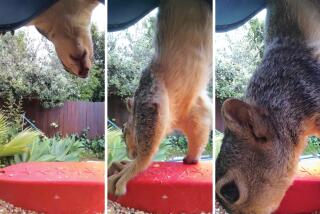Gnawing Squirrels Damage Tree and Hoses
- Share via
Question: We live in an older, well-developed area of the hills by the Hollywood Bowl, which remains fairly wet throughout the year. In the last year, squirrels have been gnawing through our rubber sprinkler dripper hoses until the hoses are severed. They have also started gnawing on the bark of an old carob tree next to our house, and we find pieces of bark on the ground every day. Since there’s plenty of water around and they’re now going for the tree, we can’t figure out what they are doing and why. Any ideas?
--A.B.
Hollywood
Answer: A couple of things are probably going on. To begin with, squirrels are rodents, one of whose interesting characteristics is ever-growing incisors that grow from the base of the jaw, two above and two below. Each tooth is a segment of a true circle, which means that like other rodents--gophers, rats and mice--squirrels must constantly whittle their teeth down.
In fact, where a particular squirrel’s diet is too soft or the animal is injured or blind, the uppers may grow back up and through the roof of the mouth, and the lowers can grow up in front of its face. Like the well-to-do ladies of old who never trimmed their fingernails, the squirrel becomes unable to perform even the simplest tasks. In the squirrel’s case, though, the absence of this grooming may mean malnutrition, even starvation.
That said, the squirrels may be simply gnawing on the hose and your tree as part of their daily grinding routine. But it may also be that they’re “debarking,” a phrase coined by biologists to describe several possibilities, including tearing off the bark to feed on sap and the cambium and phloem tissues that lie underneath the bark, to feed on insects or to collect nesting materials.
Unless the debarking stops quickly, you may need to protect your tree before it becomes permanently damaged. Place diversionary corn cobs away from the tree and wrap the trunk with hardware cloth to prevent the bark stripping.
Rattlesnakes Worry Santa Monica Hiker
Q: Rattlesnakes are everywhere in the Santa Monica Mountains. Walking with my poodle, Rene, I’ve seen five so far. As a child in Arizona, I was taught to stand still if I heard the rattle. But now people are telling me to jump the other way immediately. What should I do, and is there any antidote I can carry with me?
--C.H.
Topanga
A: The only rattlesnake you’ll run into in the Santa Monica Mountains is the Southern Pacific rattler, so there shouldn’t be any doubt what you’re seeing the next time you run into one. Unless, of course, you’re mistaking all those snakes for other species.
Gopher snakes, for example, are quite abundant in a wide range of habitats, including dry, scrubby areas like the local mountains. Not only can they look a lot like rattlers, they can be quite adept at mimicking them when provoked. Nifty tricks include vibrating their tails, flattening their heads into a characteristic diamond shape and coiling up as if ready to strike.
Regardless of the species, however, you should absolutely not bolt from the sounds of a rattler unless you know exactly where the snake is. Rattlers are not loud, and if you can hear one, chances are it’s pretty close. Remember that, like you, it’s scared and feeling threatened and is most likely backing away from you. Stand as still as possible until you see where it is. Wait until it’s moved far enough away--your body length is more than sufficient--before you slowly back away from it.
According to Russ Smith, curator of Reptiles at the Los Angeles Zoo, 25% of rattlesnake bites are dry, which means the snake actually failed to deliver any venom when it bit. Another 25% are so low in venom that anti-venom is unwarranted as a treatment, and the other 50% may be candidates for anti-venom. Though this is useful for you, it does no good for your pet, which might be better left at home rather than walked in areas frequented by rattlers.
Snakebite kits are essentially little suction cups that don’t do an effective job of removing the venom, and trying to use them wastes important time. Carrying antidote isn’t necessary or advised because it’s possible you won’t be envenomated at all. Besides, the anti-venom, which is manufactured in horses, can cause an allergic reaction in some people, with the effects often outlasting those of the snakebite.
Leave it up to a doctor to decide whether you need the treatment. The latest thinking is simply to get yourself to medical treatment as quickly as possible. If there are that many snakes where you’re hiking, you might try including a hiking buddy with opposable thumbs who can manage a cell phone in an emergency, especially if you’re hours from medical help.
Children, babies and pets are always in greater danger when they’re bitten because they’re more near the size of the prey the snakes eat. Teach kids to wear jeans and heavy hiking boots, stay on paths, never step over a log or put their hands on a ledge they can’t see.
Remember, when you’re hiking, you’re in the snakes’ home--not yours. Leave rattlesnakes alone and you’ll be rewarded with the same treatment.
Attacking Birds Make Three Stooges Noises
Q: I am a security guard for a large aerospace company. When I am patrolling, I constantly run into a certain bird in the parking lots I patrol. This wouldn’t be unusual except I work graveyard shift. The birds make a Three Stooges-type noise and almost attack my vehicle. I have no idea what kind of birds they are. Can you help me?
G.S.
Hawthorne
A: I consulted with Martin Byhower, author of the Palos Verdes Peninsula chapter in the newly revised American Birding Assn.’s “A Birder’s Guide to Southern California” and director of Birding Southern California and Beyond, which offers for-hire privately guided birding and natural history trips in the U.S. and abroad.
According to Byhower, the only bird in your area that makes a Three Stooges call is the Bullock’s Oriole. But since it’s both very colorful, which you didn’t mention, and shy, we agree that your mystery bird is probably a mockingbird.
Every spring, readers report that strange birds are making a racket in the middle of the night. In fact, it’s quite common for unmated male mockingbirds to sing into the wee hours in the spring.
Mockingbirds can be aggressive, mimicking other birds, mammals--even the sounds of machinery and traffic. Since this is considered a highly adapted skill, today’s ornithologists prefer to call the birds’ mimicry “vocal appropriations.” Some folks say they even sound as if they’re mewing or laughing.
Got critter conflicts? Send your queries to wildlife biologist Andrea Kitay at P.O. Box 2489, Camarillo, CA 93011, or via e-mail to [email protected]. Please include your name and city. Questions cannot be answered individually. Visit https://www.livingwithwildlife.com to see answers to frequently asked questions.
More to Read
Sign up for Essential California
The most important California stories and recommendations in your inbox every morning.
You may occasionally receive promotional content from the Los Angeles Times.










